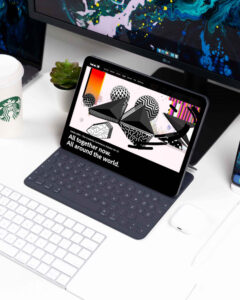Argentina is one of the many examples of Latin American countries that develop the design as their history progresses. Although the first advertising agencies and schools of graphic arts emerged between the late nineteenth and early twentieth centuries, graphic design assumed the most diverse conceptual forms for many decades. The design itself went through a period of lack of definition and little relevance of visual products.
The design field had many ups and downs marked by the vortex of a very changing socio-political context. In Argentina, the events surrounding design did not coincide with the events that took place in Europe. It was not due to a lack of debates or institutions such as the Schools of Arts and Crafts, but because the horizon of social understanding was different.
Political conflicts and other social needs delayed the progress. But despite going through several periods, graphic design in Argentina has captured the world’s attention due to its rapid growth. Today, design, which was shaped by state policies and the global context, is characterized by its eclecticism and renowned designers who were part of the construction of national identity in certain contexts.
Foundational stage
The foundations of design in Argentina began to develop as a result of the debates developed within the field of plastic arts. With the arrival of the masters of International Modern Architecture, the legacy of the plastic avant-garde arrived through the generation of young students. More specifically, with those who were related to the avant-garde of Concrete Art. This movement is based on the importance of plastic elements: point, line, color, space, and movement. At the same time, on a political level, Concretism thought of itself as a political broadening of the aesthetic horizon.
The Concrete Art movement in Argentina, which emerged in the mid-1940s, was born as a space from which to install the most radical affirmations of European concretism. It was also the first appearance of a solid local critique of the traditional concept of Fine Arts and the simultaneous updating of the legacy of the aesthetic avant-garde. Edgar Bayley and Tomás Maldonado were the key figures insofar as they built its theoretical body. Particularly, the interdisciplinary path of Maldonado added to his early interest in Industrial Design makes him one of the leading international referents of the origins of Design as a discipline.
The reading of concrete artists conditioned the recovery and knowledge of movements such as Cubism, Constructivism, and the non-figurative tradition. Students projected modern works and experienced expanding of the theoretical universe of forms to make a political statement. The subsequent diffusion of the cultural circuit of the “moderns” undoubtedly constitutes the new horizon of reference that links the modern in Architecture with Design. Therefore, it marks the beginning of the construction of the disciplinary field of design in the country.
However, at the beginning of the 1950s, the world had already changed and, with it, the avant-garde conceptions about art and the production of objects. European and American novelties were beginning to be known in Argentina and, with them, the Bauhaus and neoplasticism approaches and the debates about the industry. The world panorama after the world wars was a fundamental factor. The transition to capitalism implied the activation of the market and industrial development. Far from seeking new markets, the focus was on the reconstruction of their own and full employment.
The industrial world needed quantity, quality, and a production line that would not stop. Technology, science, and product research were the keys that could guarantee a rapid recovery. It was the moment when design ceased to be recognized as art and instead moved into the territory of the production of everyday products. It was the definitive consecration of design but understood only as industrial design.
Meanwhile, the growth of design in Argentina is due to public education. During the ’50s and 60’s the National University of La Plata, and the National University of Cuyo were the first institutions to implement industrial design as a career. At the same time, the Faculty of Architecture and Urbanism (FAU) of the University of Buenos Aires (UBA) was created. It was the beginning of a long process that would mark the particularities of design in the country.
The Argentine renaissance
Graphic design as such started as a profession in Argentina in the 1960s. Years before, what we understand today as graphic design was nothing more than a service, an annex to the presentation of useful forms. It was a synthesis of the contributions of science, technique, and aesthetics, oriented to the market. The importance of communication and the rise of the media, particularly television, replaced “industry.” It was no longer about the utilities of everyday life but about the messages and the power of visual signification.
It is no coincidence that the early interest in design in La Plata, Buenos Aires, was not accidental. The students were notably influenced after the didactic experience of Hochschule für Gestaltung in Ulm, Germany. This school, founded by Inge Aicher-Scholl, Otl Aicher, and Max Bill, reformulated Bauhaus pedagogy. The birth in the 1960s of Industrial Design and Visual Communication Design as separate careers also marks the perception of a clear difference between the two and a distinction in their objects.
The country had a project for its graduates and the identity of the nation. But in 1976, the tragic military dictatorship represented a dark period. Graphic products were vetoed, and the teaching of design was equally silenced. Students, professors, and university authorities disappeared at the hands of the military. For this reason, until the return of democracy in 1982, design suffered a pause. From the 80s, the second period of the discipline began in different national universities.
Design aimed at consolidating the rule of law, civic virtues, and democracy. It began to be part of the public space. All the events marked the most intense stage of graphic design as a discipline, being fundamental in political campaigns, street advertising, and urban signage. It continued to transform according to the changes in the country. At the beginning of the 90s, the presidential change brought reforms to the State and privatization of public companies. Therefore, the role of graphic design was fundamental and more noticeable, as companies needed to renew their image.
In the 90s, sizeable worldwide design and corporate communication studios began to arrive in Argentina. The concept of “total design” was incorporated at the service of the new concept “everything means, everything communicates,” from stationery to company buildings, including product design, interior design, furniture, logos, advertising, promotion, merchandising, etc.
Graphic designers in Argentina
Ruben Fontana
website: http://fontana-d.com/

The long-time designer has his studio called Fontana Diseño in Buenos Aires. He has been in business for more than 40 years and specializes in institutional and corporate identity projects. Fontana has offered master classes at masters and postgraduate levels in several countries, including the Netherlands and Canada.
He has specialized in highlighting the importance of typography in design. Thanks to him, typography was incorporated as a subject in the design career at the University of Buenos Aires. Besides, Fontana was the first Argentine representative in the International Typography Association. He was awarded the National Design Award of Cuba for his contributions to the education and development of Latin American design.
Pablo Bernasconi
website: http://www.pablobernasconi.com.ar/

Bernasconi began his career collaborating as an illustrator for El Clarín, one of the most important newspapers in Argentina. His work currently appears in the most important English-language newspapers such as The New York Times, The Wall Street Journal, and Time magazine.
He has lectured in Mexico, Edinburgh, Chile, London, and other countries. His work has been recognized with eight awards for excellence by the Society of Design Journalism. The Argentine designer has created the graphic identity for the HBO series, The Leftovers.
Pablo Bernasconi assures that illustrators and artists are cultural artifacts, gears that shape the identity of each culture.
Agustina Guerrero
website: https://agustinaguerrero.com/

Graphic designer and illustrator, she gives voice to women through her illustrations. In her work, she projects the concerns and conflicts shared by women in their daily lives.
Author of three books, she took her work from Argentina to Barcelona, where she currently resides. Her character “La Volátil” triggered the success of her professional career when she published it on her personal Facebook profile. The designer, who also gives lectures, says that the success of “La Volátil” is due to the identification of many girls with the character.
Jorge Alderete
website: http://jorgealderete.com/
From Argentina to the world, the designer better known as Dr. Alderete has conquered the hearts of the public who have attended his exhibitions, inaugurated in various cities worldwide. He has created more than a hundred graphics for Argentinean bands such as Los Fabulosos Cadillacs, Andrés Calamaro, and Twin Tones. He has also worked with Los Straitjackets, a band from the United States, and Café Tacuba, Mexico.
Since 2015, he belongs to the Alliance Graphique Internationale, which brings together the world’s leading graphic artists and designers.
There are also multiple graphic design agencies of great importance at local and international levels. Among them, we can name the following:
Hachetresele Studio
website: https://h3lag.com/

Located in La Patagonia, province of Neuquén, it is one of the most relevant studios in Argentina since its appearance in 2004. Its portfolio of works is characterized by elegant and minimalist designs reminiscent of Dej Still and Russian constructivism. Their subtlety allowed their creations to travel all over the country.
Inland Studio
website: https://inlandstudio.tv/

Javier Bernales, Gonzalo Nogues, and Julian Nuñez, its founders, after years of experience in animation studios, felt the need to create a place to develop their passion for design and, of course, for everything animated. Each project serves as an excuse to create new universes. All their pieces contain a message that they try to convey concretely and creatively.
BUNKER3022
website: https://bunker3022.com/

Bunker is a studio specialized in branding, and, according to its creators, it was born from a taste for good design and aesthetics. They work both in Argentina and around the world. Their work is versatile, ranging from a seafood brand to adhesive tape packaging.












